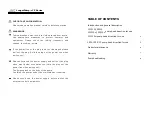
Adjustment Procedures
Figure 1 shows the set-up for one
solenoid. If the valve contains two
solenoids, the set-up and the following
procedure should be repeated.
CAUTION
Applying more than 10 volts at input C
may result in damage to the power plug.
Deadband adjustment
A.
Turn potentiometer R3 on
the power plug fully
clockwise (no deadband
compensation) and R1
fully counter-clockwise
(maximum ramp rate).The
red LED will turn off (it
turns off to signify an “off”
condition valve, when
input voltage is less than
100 mV).
B.
Adjust command
potentiometer until the
voltmeter reads 0.25 volts
at connection C.
C.
Slowly adjust
potentiometer R3
counter-clockwise until
movement at the actuator
is detected.
Deadband compensation is set.
Gain adjustment
A. For many applications the
valve gain may simply be
set to a maximum by
turning potentiometer R2
fully clockwise.
For any other gain setting:
A.. Calculate the maximum
speed of the actuator.
Calculate 80% of this
maximum speed.
B.. Set command
potentiometer to provide 8
volts at C (8 volts is 80% of
maximum input voltage.
C.. Slowly adjust
potentiometer R2 until this
80% speed is observed at
the actuator.
Valve gain is set.
Repeat the deadband adjustment and
the gain adjustment steps at least once
more since adjusting one parameter
affects the setting of the other.
Ramp rate adjustment
A.
For most applications:
Set R1 fully clockwise
(minimum ramp rate). Run
the actuator for different
increasing counter-
clockwise settings of the
potentiometer R1 until
slight hydraulic shocks in
the system are observed.
Back-off R1 clockwise until
the shocks just disappear.
Fastest shock-free ramp
rate is set.
B.
For any other ramp rate:
Run the actuator for
different increasing CCW
settings of the
potentiometer R1, until the
desired velocity ramp is
observed at the actuator.
100% Deadband
compensation
0%
fully CCW
Note that all adjustment lies within
40% of the potentiometer rotation.
~40%
Figure 3. Sensitivity of deadband
adjustment to potentiometer R3 (typical).
flow rate
(or
“gain
”)
fully CCW
fully CW
volt input
40%
Figure 4. Sensitivity of deadband
adjustment to potentiometer R3 (typical).
fully
CCW
fully
CW
Ramp time
Note that adjustment is very non-linear and
most adjustment lies within 40% of the
potentiometer rotation range for ramp-up
and 20% of the adjustment range for
ramp-down.
20%
40%
Figure 5. Sensitivity of deadband
adjustment to potentiometer R3 (typical).






















